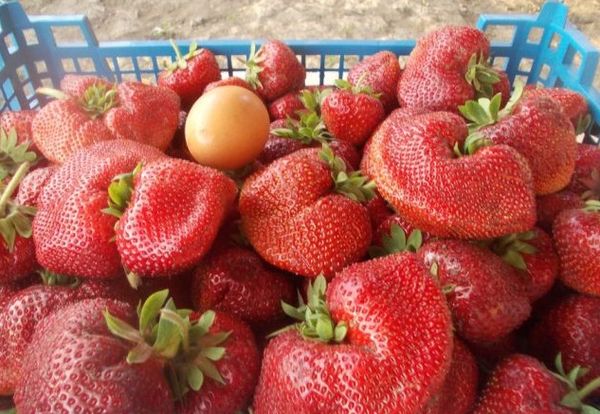No other sort of strawberry has had so much controversy and discussion as about Chamora Turusi. Large berries, reaching the size of a small apple, raise doubts about the origin. The feeling, however, is quickly replaced by admiration after the first trial.
The aroma of forest strawberries and delicate structure of the pulp can not leave indifferent any gourmet.
Table of contents
Description of Chamora Turus
The variety was bred supposedly by Japanese breeders who crossed two “giants” among themselves. For certain information is unknown, whether it is the fruit of the works of scientists, or farmers.
The bush grows tall with a powerful sprawling crown of bright green leaves and long whiskers. Peduncles thick, greens and large flowers.
The average productivity of a culture from a bush is from 1.8 to 3 kgberry weight from 80 to 110 grams. Chamora turus matures relatively late - in the second half of July (15-25).
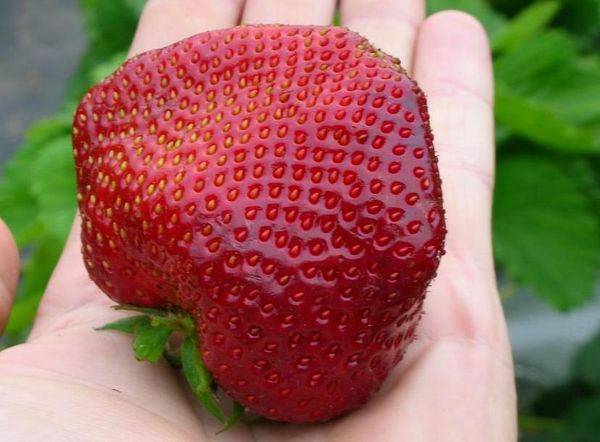
In the first year after planting, the bushes do not give bloom, flowers and flower stalks are removed with a sharp knife. The next two years, strawberries pleases abundant harvest and large fruits. 4-5 year sizes are reducedas the fruiting period. This is a kind of signal to transplant into a more nutritious soil.
The climate for growing berries suitable moderate, fertile soil. The skilled gardeners manage to grow chamora turus in northern conditions. True, the fruiting season is short, and fruits on average weigh 35-50 g. This achievement is made possible by grade frost resistance.
But to plant tubers in regions with a hot climate is not worth it, the plant from the drying of the soil dies. According to gardeners plant does not freeze out without special cover at -33 degrees. When using agrofibre productivity increases. Winter culture stands with dignity with proper preparation and care.
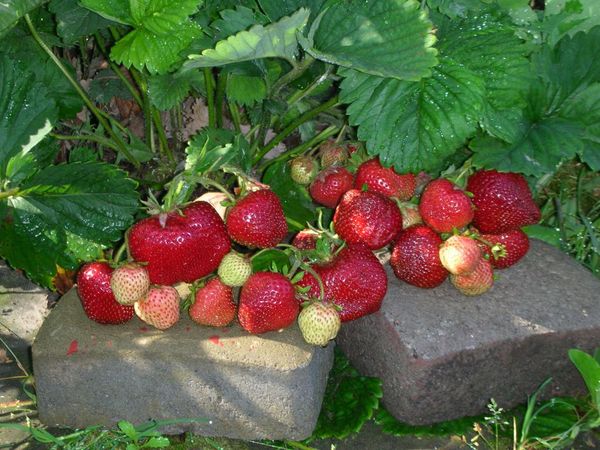
Characteristics of berries
Chamora turus berry has a rounded conical shape with folds and scallops. The average weight is 80 grams, but with proper farming techniques you can get the fruits 110-130 gr.
Ripe strawberries are characterized by a dark red color with a brownish tinge. The smell is pronounced strawberry. In August, the bed is abundantly covered with fruits, the picture is downright alluring for children and adults.
Culture manages to bear fruit without proper care, but the weight of the fruit in this case rarely exceeds 40-50 grams. At one place strawberry bears fruit. up to 12 years with the most primitive irrigation.
This fact is not considered in the context of lack of fastidiousness. On the contrary, the variety is not for the lazy. He rather demanding, gentle and even capricious.
Breeding history and region of growth
The strawberry pedigree is not known for sure, but it is believed that the hybrid was bred by Japanese scientists using Gigantella Maxim or Queens elizabeth.
The similarity with varieties is also mentioned in the scientific description. Therefore, Japan is considered to be the birthplace of Chamora Turusi.
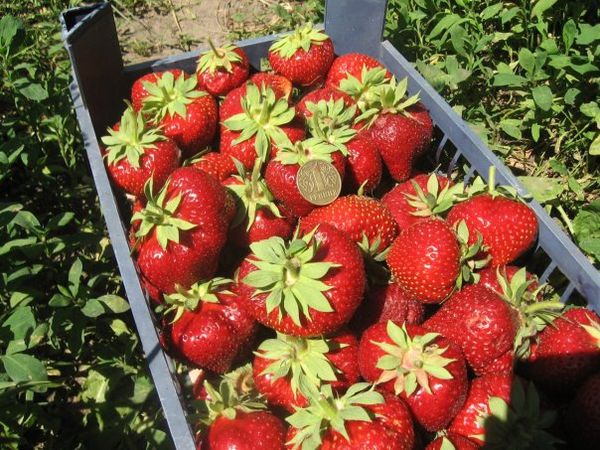
The advantages and disadvantages of the variety
To make the picture about the variety clearer, you need to familiarize yourself with the advantages and disadvantages of culture.
The main characteristics of the chamora turus include:
- big sizes berries with a pronounced strawberry aroma and taste;
- fruits are strong, easy to transport, while maintaining integrity;
- It can grow and bear fruit in one place for many years;
- frost resistance;
- the culture is not demanding to bait;
- resistance to the formation of powdery mildew.
When growing strawberries should take into account its weaknesses:
- watering sensitivity at different stages of bush development;
- can attack ticks and slugs;
- extensive land is required for landing;
- associated diseases: verticillus, gray mold, brown and white spot.
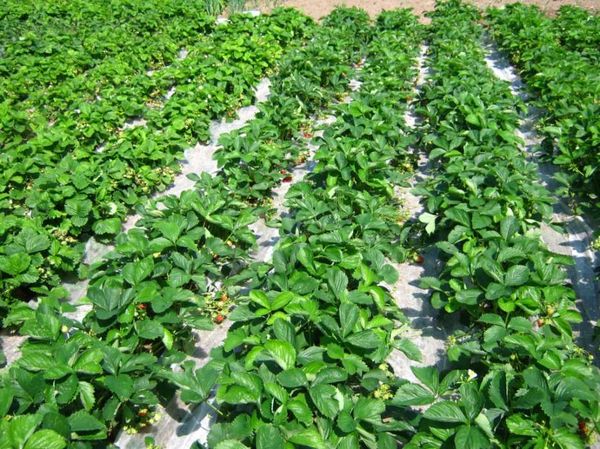
Nuances of growing Japanese strawberries
The rules for growing chamora turus are generally similar to other strawberry varieties. But some features still exist. They should be considered to avoid unpleasant surprises.
- When planning beds special attention is paid to the distance between the bushes. In the thickened culture, pests take root well, and fungal diseases develop. Recommended intervals between tubers are 30x60 cm. In regions where high humidity is observed most of the time, the rate rises to 50 cm.
- The presence of low sides on the beds (20-25 cm) makes it possible to fix the agrofibre for obtaining an earlier harvest and protecting the plants from late frosts.
- Before planting soil seedlings necessarily enriched organic or mineral fertilizers. Chamora turus loves nutritious soil.
- Watering during fruiting is reduced. Excessive irrigation affects the taste of berries.
- Tubers do not bury into the soil. This can trigger the formation of gray mold. Also, improper planting reduces the taste of berries.
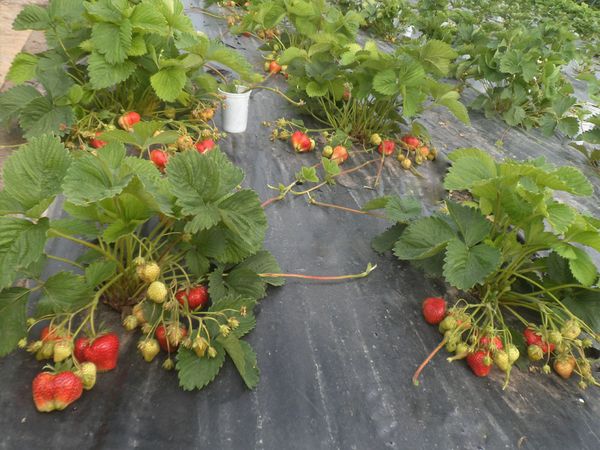
Planting seedlings
Place for planting seedlings is selected well lit (at least 12 hours a day). In areas with slopes preference is given to elevations. Wetlands and saline soils will not work.
The soil must be thoroughly loosened and enriched with humus or other organic matter. Chamora turus also likes: mineral fertilizers, mullein, chicken droppings (use dosed and very carefully so as not to burn the plant).
When performing the marking of the beds it is necessary to adhere to the recommended intervals between tubers: 35x60 cm (for 1 m2 of 4 plants).
It is not necessary to do the holes too deep; 12-15 cm is enough. The success of growing a crop depends in particular on the quality of the planting material.Experienced farmers recommend to prefer the sockets obtained from the first kidney of the antenna.
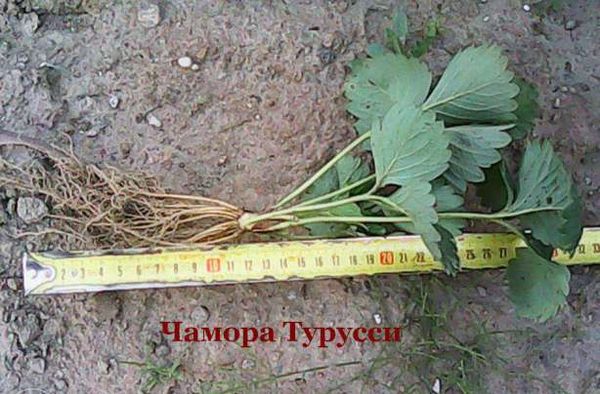
The ideal conditions for rooting is planting escape in a plastic cup filled with peat. The seedling is placed in the ground together with a lump so that the plant experiences less stress. If the quality of seedlings is in doubt, the root system should be treated with a growth stimulator (Radifarm solution).
In the middle lane you can do it. in late August, and in warm regions, characterized by little snow in winter, in May.
In temperate climates, preference is given to the autumn period, when the most favorable temperature conditions and humidity levels are established. Experts recommend cooking beds in the fall: dig and mix the soil with dolomite flour.
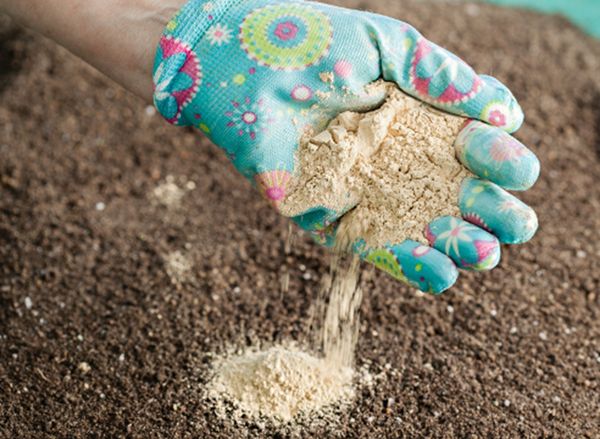
Mandatory activities for the planting of new tubers include:
- soaking strawberry roots in a weak solution of potassium permanganate one day before the start of work;
- processing them in a mixture of manure and clay, followed by 2-hour drying;
- forming a small mound in the hole to set a tuber;
- bedding and soil compaction.
After planting, strawberries are watered abundantly until the end of the adaptation to the environment.
Growing conditions
Watering
After the start of fruiting, the amount of water decreases. It is important to focus not on the recommended figures, but on the degree of soil moisture.
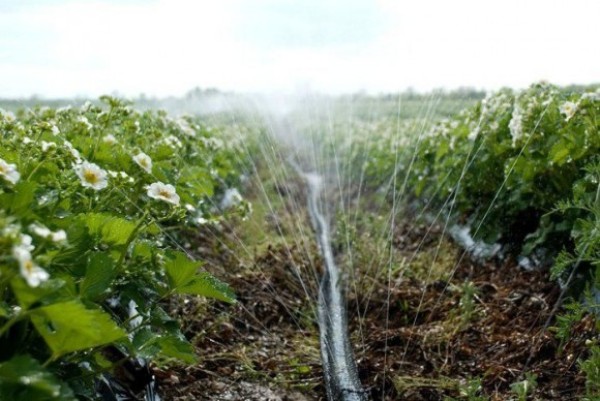
The irrigation frequency is 1 time in 3-4 days. Strawberries, though they are a moisture-loving crop, can be overfilled by an overabundance of moisture.
The ideal option is considered to be a drip system, creating a comfortable living environment. Irrigation irrigation is also suitable. Watering plants need to mid-autumn, in the absence of torrential rains.
Soil and fertilizer
With proper care, strawberries start to bear fruit. in the second year after disembarkation. Under adverse conditions, get a harvest to turn out in the 3rd year. To prevent the soil from drying out and the ripening of ripening fruits, it is necessary to mulch the surface of the soil with straw, sawdust or other covering material.
In the second half of August you need to perform trimming leaves and whiskers. The surface of the soil is treated with a solution of fungicide (2%). If there were soil bald spots at the root, cover them with a substrate.

Before the onset of cold weather, the beds are covered with a layer of sawdust or any other dead wood (cushion thickness not less than 5-7 cm). As an option to use agrofibre.
Breeding methods
There are several ways of breeding chamora turus.
Usa
The easiest way to get a new seedling is from a mustache. To do this, from a plant that has reached 2-3 years of age, the most promising options (up to 5 pcs.) That grow closer to the outlet are selected. They can simply be drowned in the ground, using a curved wire, or cut to be placed in a glass with a solution that stimulates the growth of the root system.
In the first case, the young shoot will take root later. 1-1.5 months (it is separated and transplanted). In the second - through 2-3 weeks mustache will take root and be ready for disembarkation.
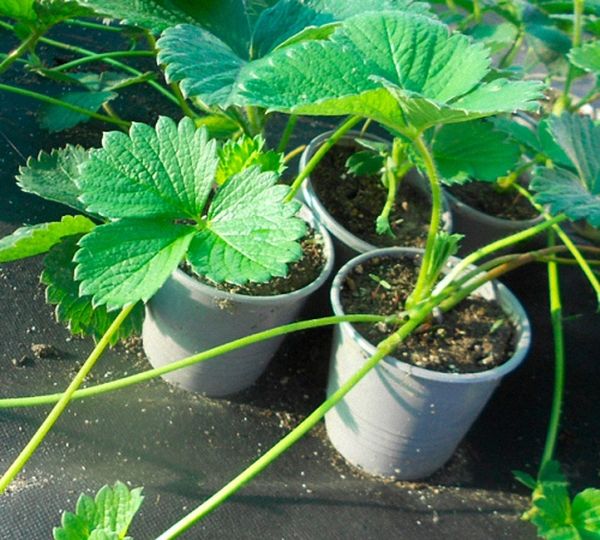
Division bush
The method of division involves the selection of a good healthy bush for later division into 2-4 parts.
Each fragment should have at least 4-5 leaves and a root length of 5-6 cm. After the procedure, the separated parts are planted in open ground.
Seeds
The process involves separation from the berries of large-sized pulp for subsequent drying. Selected seeds are planted in March in a container with a substrate (universal soil, peat, humus) and covered with a lid.
The next two weeks the disembarkation is stored in the refrigerator, after which it is placed on the window sill and periodically moistened by spraying. After formation 2 leaflets the shoot is transplanted into a separate pot. And after the appearance 5-6 sheets - in open ground.
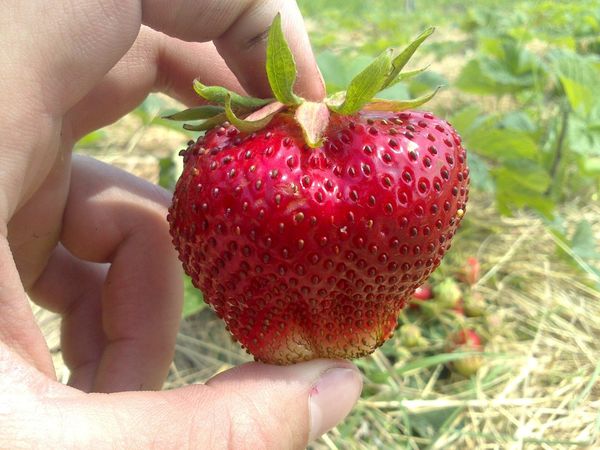
Diseases and pests
Strawberry exposed fungal diseasesbut most often it affects verticillosis. Treatment is not always effective, so it is better to carry out preventive measures in a timely manner.
Verticillosis
With the defeat of the bush verticillosis noted plant wilting and the formation of yellow-red leaf spots with an almost black bloom on the tuber. For treatment are used: Benorad, Fundazol. They can handle a sick plant no more than 3 times per season.
As a preventive measure, before planting, the root is soaked in a weak solution of potassium permanganate. In the period of development, damaged leaves and twigs are removed in a timely manner.
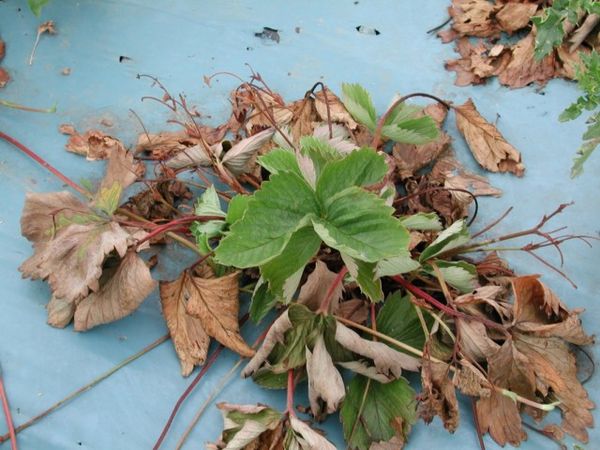
Fusarium
Fusarium appears yellowing, fast drying sheetsfalling apart outlet. The mustache becomes brown.
Used for the treatment of: Benomil, Benorad, Fundazol. If it was not possible to save the plant, a portion of the soil in its place is treated with Nitrofen.
As a preventive measure, the following measures are taken: timely transfer of the beds to more fertile soil, regular introduction of dolomite flour into the ground, spring processing of the site with a fungicide.
Gray rot
Gray rot is characterized by the formation dark gray spots on the berry, covered with light nap with small black dots.
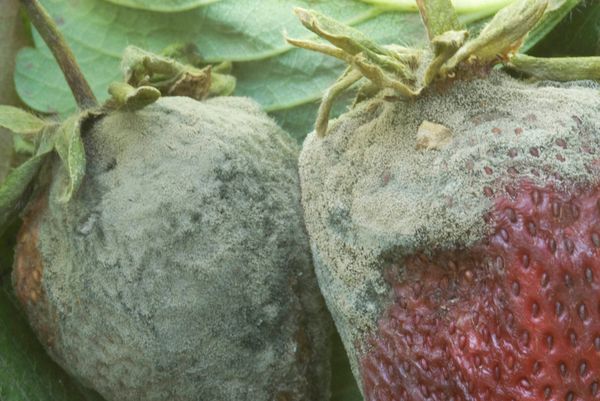
Preparations are used for the treatment: Fundazol, Teldor, Bayleton, etc. As a preventive measure, it is recommended to observe the following rules: leave sufficient when disembarkingthe space between the tubers, timely rejuvenate the beds, do not use fresh manure for bait.
Black root rot
Rhizoctoniosis or black root rot affects the root system, manifested in the form of brown spots, drying and falling leaves.
Pests
From pests on strawberries larvae beetle and strawberry mite. In the first case, intensely yellowing and falling leaves are observed at the beginning of the season. And in the second - their deformation and twisting into tubes.
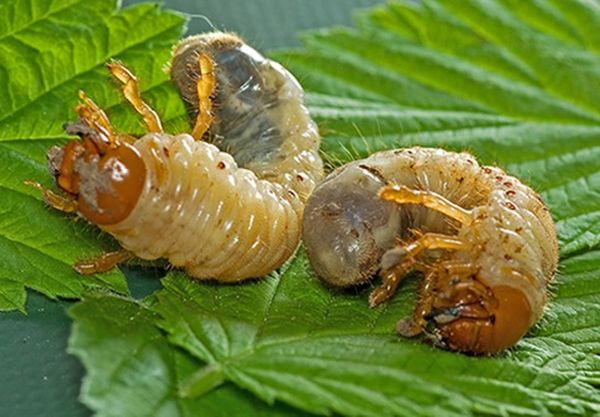
When pests are detected, they should be responded instantly in order to save the plant. It is necessary to spray the bushes with special preparations: Karbofos, Neoron, Phyto and other.
From the larvae May beetle prophylaxis will help - the treatment of the beds before disembarking Bazudin, Anti-Chrushka, Aktar, planting nearby turnips, lupins and white clover. Appearance strawberry mite prevents a contrast shower (alternately spraying with hot and cold water).
Everybody can grow a large berry; you just have to show some patience and provide the plant with proper care.
